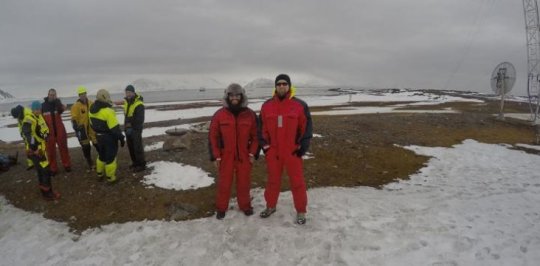[ad_1]
Understanding how the ocean works is like putting together a million-piece puzzle. There are many questions; finding answers takes time, resources, and opportunity. But even when scientists believe they know how the pieces fit together, new knowledge can change the shape of the puzzle.
A paper recently published by Dr. Jeffrey Krause of the Dauphin Island Sea Lab and the University of South Alabama adds another piece to the puzzle in understanding the impact of diatoms on the Arctic Spring Bloom.
Diatoms are single-celled algae, the tiniest plants at the bottom of the oceanic food chain, and their ecosystem function is similar to grasses on land. Harnessing the sun’s energy through photosynthesis, diatoms transform carbon dioxide into organic matter, with oxygen as a byproduct. Unlike other single-celled algae, diatoms have an outer shell made of glass, meaning they also need to consume silicon (main component of glass) in the water.
In 2015, Dr. Krause’s conversations with the Wiese Distinguished Lecturer, Dr. Carlos Duarte, led to Dr. Duarte and his colleague Dr. Susana Agustí to reach out with an opportunity for collaboration to test the hypotheses discussed in Mobile.
Krause believed that if there wasn’t enough silicon in certain regions of the Arctic Ocean, diatoms would slow their growth, and this would alter how much organic matter was produced during the most productive time in the region. While such an idea had been proposed 20 years earlier, nobody had tested this hypothesis directly.
In a nutshell — or glass shell — declining silicon concentrations in the European sector of the Arctic Ocean could mean less diatom production, which would then impact secondary producers (e.g. krill, organisms which are consumed by fish, whales) and the potential organic matter sinking to the benthos, or seafloor, during the Arctic Ocean Spring Bloom. Fewer (or smaller) diatoms available, could translate to less food for krill, fish, and mammals.
“We do know that silicon has been declining in the European Arctic Ocean since the early 1990s,” Krause explained. “But how that decline has affected diatoms was unclear, because nobody had directly examined diatoms using the specialized tools and approaches we use in my lab.”
Drs. Duarte and Agustí provided Krause and a PhD student, Israel Marquez, berths during a research expedition to the European Arctic around Svalbard supported by the Norwegian Research Council. Krause and this team were able to confirm the suggestion that a lack of silicon in the water reduced diatom production, in fact this was the case in 95 percent of samples collected.
“This is an exciting first step in our understanding of how the spring diatom bloom functions in this region,” Krause said. “These data have been a catalyst for new ideas and future work. Given the Arctic Ocean is warming twice as fast as the globe, on average, understanding how diatoms function now, will give us a better ability to predict how they may change in the coming decades.”
Story Source:
Materials provided by Dauphin Island Sea Lab. Note: Content may be edited for style and length.
[ad_2]















